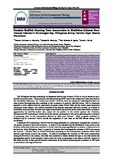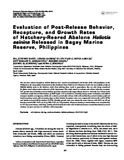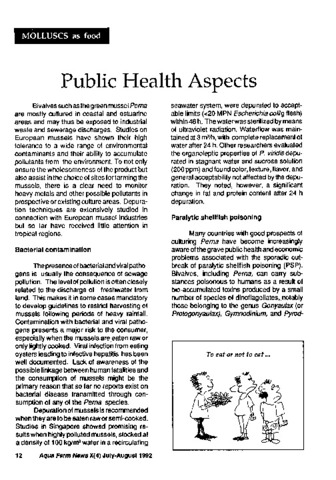Paralytic shellfish poisoning toxin accumulation in shellfishes collected from various habitats in Murcielagos Bay, Philippines during harmful algal blooms occurrence
Share
Abstract
This study aims to determine whether the habitat of bivalves plays an influence in the occurrence of tropical shellfish toxicity during toxic red tide bloom occurrences in Murcielagos Bay, Misamis Occidental, Philippines. Various shellfish species were collected during the occurrence of red tide blooms. The type of habitat and the shellfish toxicities were investigated. Likewise, the phytoplankton profile in the seawater column was assessed. Results of our study revealed that the occurrence of shellfish toxicities was habitat specific in spite of the fact that the causative organism Pyrodinium bahamense var. compressum was present in low concentrations in the sampling sites. Shellfish collected from sea grass, coralline area, and seafloor habitats were notably susceptible against the paralytic shellfish poisoning toxin contamination compared to those samples obtained from soil substrate. Continuous monitoring of areas that are affected with shellfish toxicity must be conducted so as to safeguard the general public’s welfare dependent on these resources.
Keywords
Pyrodinium bahamense var. compressumSuggested Citation
Narceda, R. J. A., Montojo, U. M., Eguia, M. R. R., & Sia Su, G. L. (2014). Paralytic shellfish poisoning toxin accumulation in shellfishes collected from various habitats in Murcielagos Bay, Philippines during harmful algal blooms occurrence. Advances in Environmental Biology , 8(7), 2262-2265. http://hdl.handle.net/10862/2251
Subject
Taxonomic term
Collections
- AQD Journal Articles [1248]
Related items
Showing items related by title, author, creator and subject.
-
Evaluation of post-release behavior, recapture, and growth rates of hatchery-reared abalone Haliotis asinina released in Sagay Marine Reserve, Philippines
Lebata-Ramos, Ma. Junemie Hazel; Doyola-Solis, Ellen Flor C.; Abrogueña, Jeff Bogart R.; Ogata, Hiroshi; Sumbing, Joemel G.; Sibonga, Rema (Taylor & Francis, 2013)The lucrative returns brought by abalone fisheries have caused overexploitation and decline of the wild population. In the Philippines, the Aquaculture Department of the Southeast Asian Fisheries Development Center has ... -
Critical Fish Habitat Management to Secure Marine Fisheries Production in Indonesia
Anjaresta, Andhika; Agung, Firdaus (Training Department, Southeast Asian Fisheries Development Center, 2016)As one of major economic sectors in Indonesia, fisheries had been targeted to contribute approximately 7% to the national GDP in the next five years. This target relies on the capacity of marine habitats and its biodiversity ... -
Public health aspects: Molluscs as food
Castaños, Milagros T.; Southeast Asian Fisheries Development Center, Aquaculture Department (Aquaculture Department, Southeast Asian Fisheries Development Center, 1992)




